Abstract
Previous studies have indicated the presence of a hereditary component in the generation of the P300, or P3, a late positive component of the event-related potential. Moreover, the dopaminergic system has been implicated in the P3. In the present study, 98 healthy Caucasian boys, mean age of 12.5 years and of above-average intelligence, were studied. The sample was composed of 32 sons of active alcoholic (SAA) fathers, 36 sons of recovering alcoholic (SRA) fathers, and 30 sons of social drinker (SSD) fathers, with none of them having yet begun to consume alcohol or other drugs. TaqI A D2 dopamine receptor alleles (A1 and A2) were determined. A significant difference in the frequency of the A1 allele was found among these three groups of boys, with the SAA group having the highest A1 allele frequency (.313), followed by the SRA (.139) and the SSD (.133) groups. The relationship of the A1 and A2 alleles to P3 amplitude and latency was also determined. The results showed no significant difference in P3 amplitude between boys with the A1 and A2 allele. However, P3 latency was significantly longer in the total sample of boys with the A1 allele compared with those carrying the A2 allele. These findings suggest that polymorphism of the D2 dopamine receptor gene is an important determinant of P3 latency.
Full text
PDF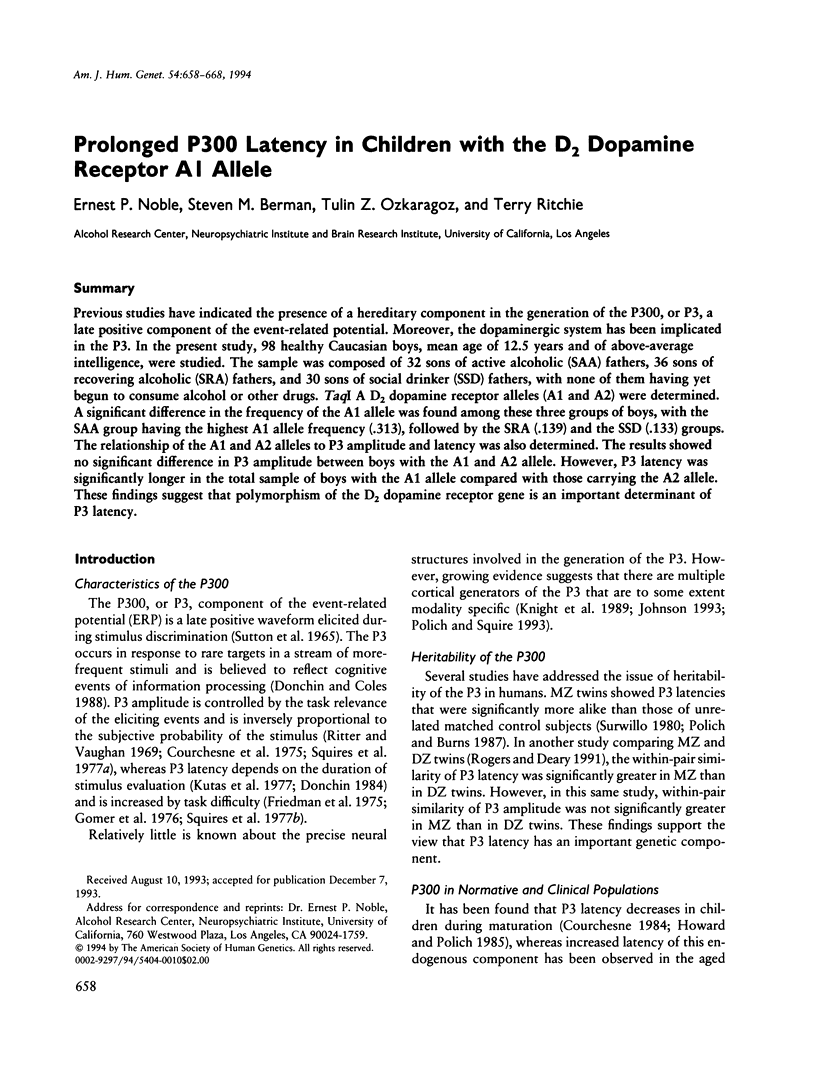

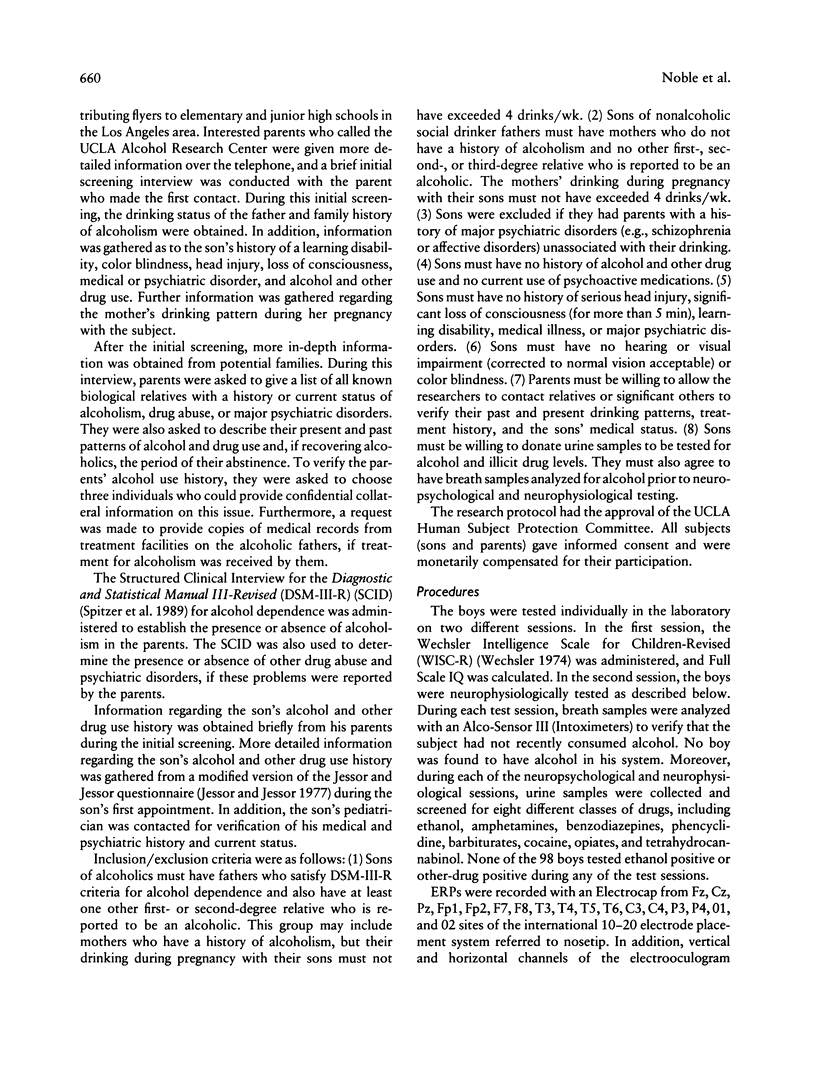

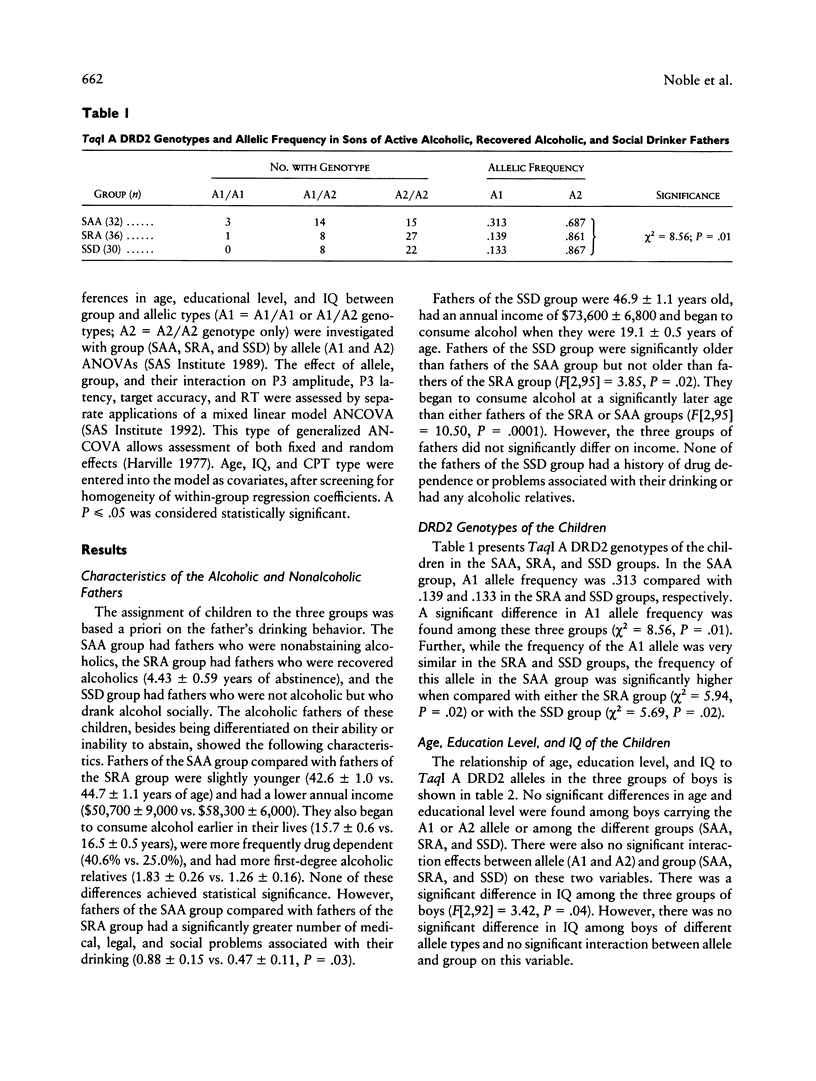
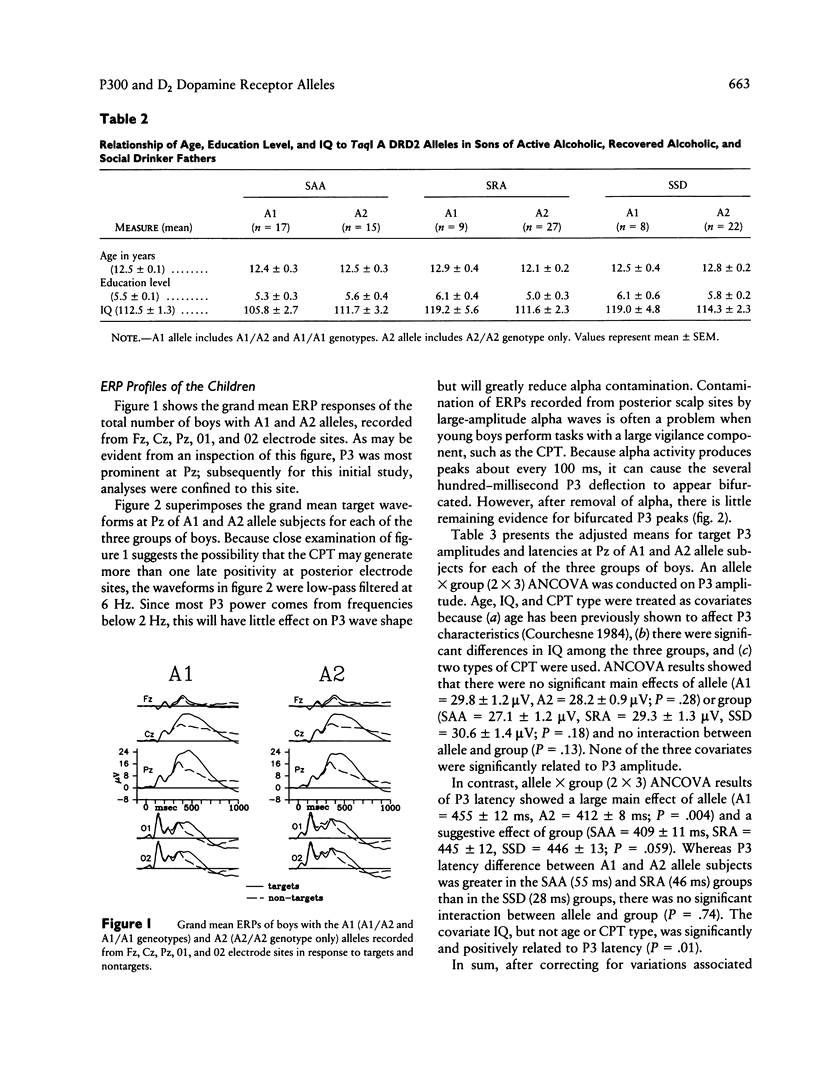
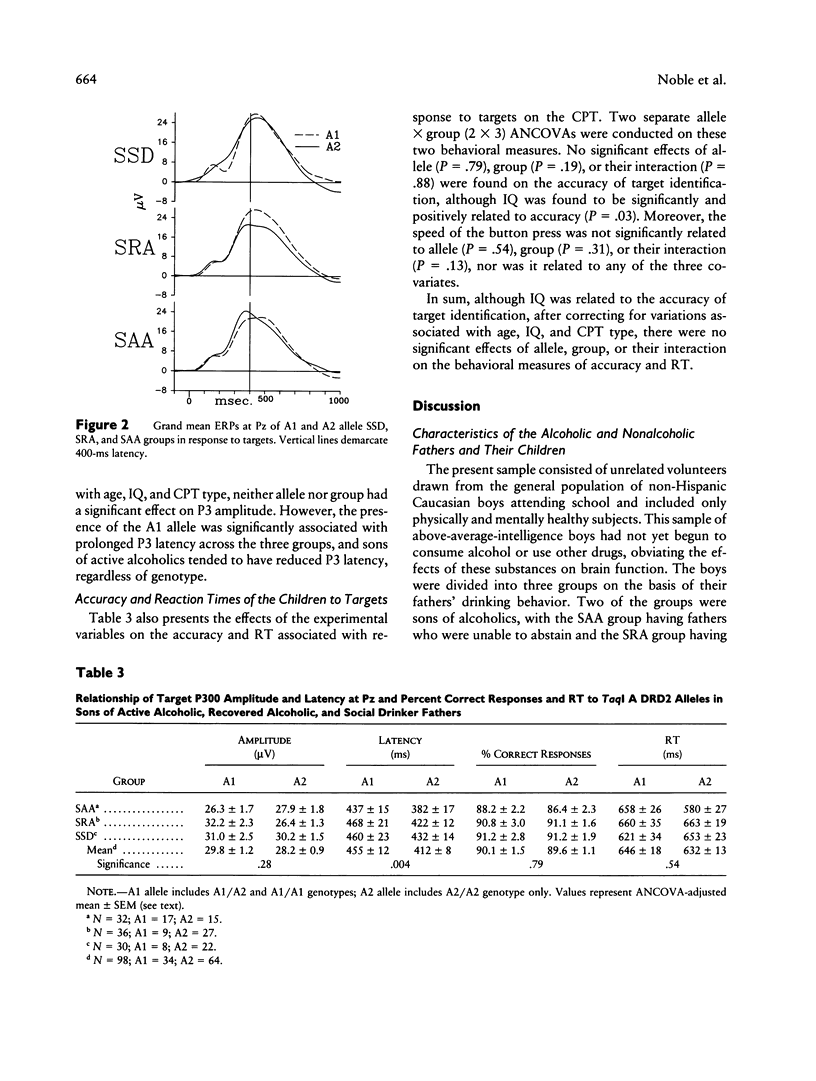
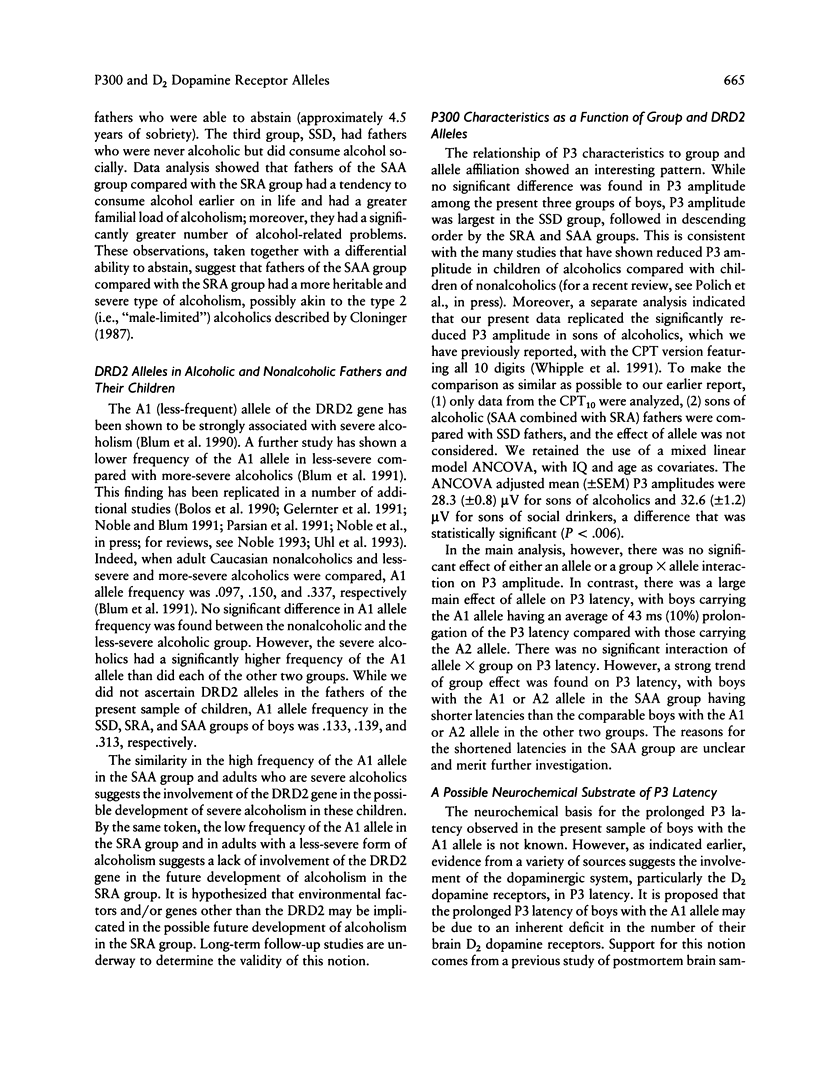

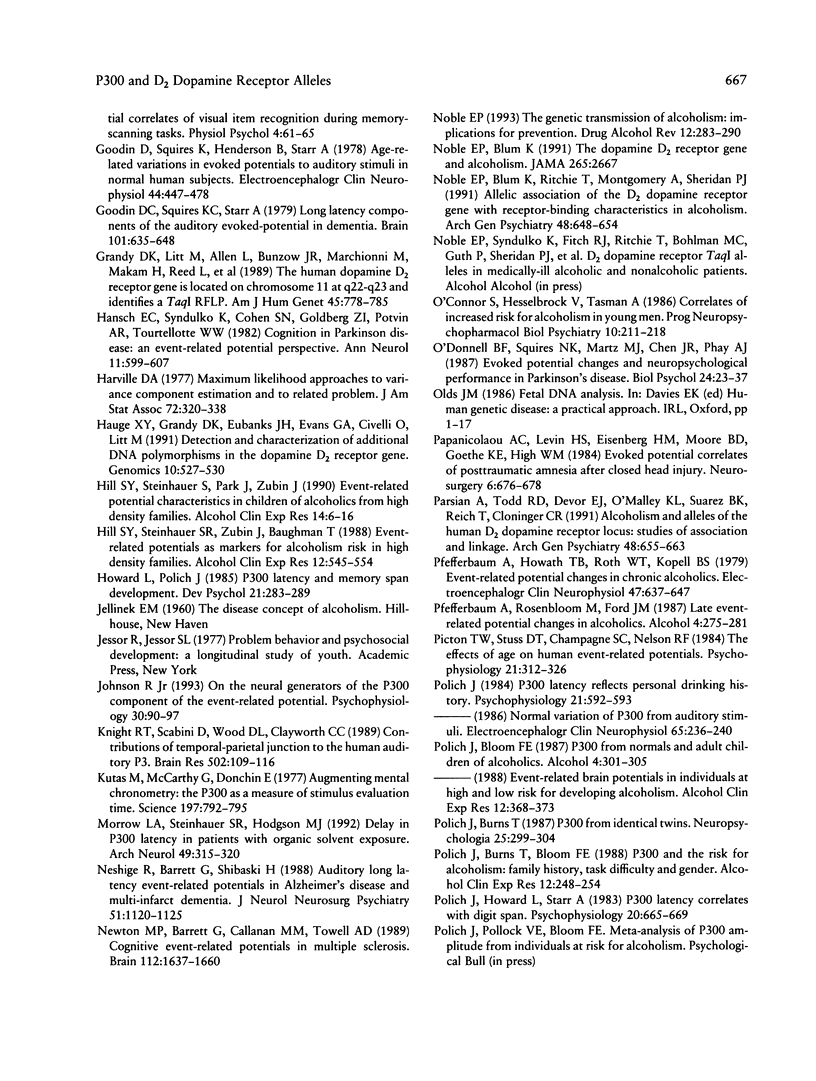
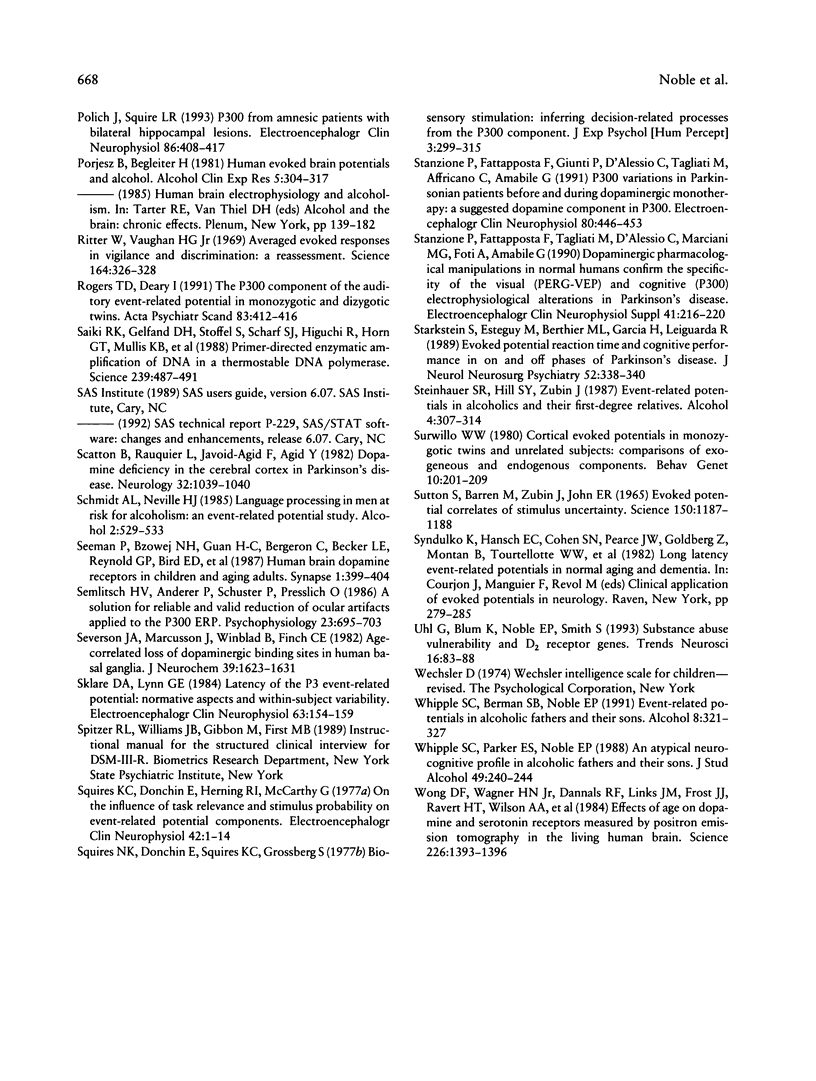
Selected References
These references are in PubMed. This may not be the complete list of references from this article.
- Begleiter H., Porjesz B., Bihari B., Kissin B. Event-related brain potentials in boys at risk for alcoholism. Science. 1984 Sep 28;225(4669):1493–1496. doi: 10.1126/science.6474187. [DOI] [PubMed] [Google Scholar]
- Blum K., Noble E. P., Sheridan P. J., Finley O., Montgomery A., Ritchie T., Ozkaragoz T., Fitch R. J., Sadlack F., Sheffield D. Association of the A1 allele of the D2 dopamine receptor gene with severe alcoholism. Alcohol. 1991 Sep-Oct;8(5):409–416. doi: 10.1016/0741-8329(91)90693-q. [DOI] [PubMed] [Google Scholar]
- Blum K., Noble E. P., Sheridan P. J., Montgomery A., Ritchie T., Jagadeeswaran P., Nogami H., Briggs A. H., Cohn J. B. Allelic association of human dopamine D2 receptor gene in alcoholism. JAMA. 1990 Apr 18;263(15):2055–2060. [PubMed] [Google Scholar]
- Bolos A. M., Dean M., Lucas-Derse S., Ramsburg M., Brown G. L., Goldman D. Population and pedigree studies reveal a lack of association between the dopamine D2 receptor gene and alcoholism. JAMA. 1990 Dec 26;264(24):3156–3160. [PubMed] [Google Scholar]
- Brown W. S., Marsh J. T., LaRue A. Exponential electrophysiological aging: P3 latency. Electroencephalogr Clin Neurophysiol. 1983 Mar;55(3):277–285. doi: 10.1016/0013-4694(83)90205-5. [DOI] [PubMed] [Google Scholar]
- Ciesielski K. T., Madden J. S., Bligh J. G., Schopflocher D. Long-term brain impairment in chronic alcoholics: N2-P3 cognitive potentials in a template-matching memory task. Alcohol Alcohol. 1985;20(4):403–408. [PubMed] [Google Scholar]
- Cloninger C. R. Neurogenetic adaptive mechanisms in alcoholism. Science. 1987 Apr 24;236(4800):410–416. doi: 10.1126/science.2882604. [DOI] [PubMed] [Google Scholar]
- Comings D. E., Comings B. G., Muhleman D., Dietz G., Shahbahrami B., Tast D., Knell E., Kocsis P., Baumgarten R., Kovacs B. W. The dopamine D2 receptor locus as a modifying gene in neuropsychiatric disorders. JAMA. 1991 Oct 2;266(13):1793–1800. [PubMed] [Google Scholar]
- Cortés R., Camps M., Gueye B., Probst A., Palacios J. M. Dopamine receptors in human brain: autoradiographic distribution of D1 and D2 sites in Parkinson syndrome of different etiology. Brain Res. 1989 Mar 27;483(1):30–38. doi: 10.1016/0006-8993(89)90031-0. [DOI] [PubMed] [Google Scholar]
- Courchesne E., Hillyard S. A., Galambos R. Stimulus novelty, task relevance and the visual evoked potential in man. Electroencephalogr Clin Neurophysiol. 1975 Aug;39(2):131–143. doi: 10.1016/0013-4694(75)90003-6. [DOI] [PubMed] [Google Scholar]
- Elmasian R., Neville H., Woods D., Schuckit M., Bloom F. Event-related brain potentials are different in individuals at high and low risk for developing alcoholism. Proc Natl Acad Sci U S A. 1982 Dec;79(24):7900–7903. doi: 10.1073/pnas.79.24.7900. [DOI] [PMC free article] [PubMed] [Google Scholar]
- Friedman D., Simson R., Ritter W., Rapin I. The late positive component (P300) and information processing in sentences. Electroencephalogr Clin Neurophysiol. 1975 Mar;38(3):255–262. doi: 10.1016/0013-4694(75)90246-1. [DOI] [PubMed] [Google Scholar]
- Gelernter J., O'Malley S., Risch N., Kranzler H. R., Krystal J., Merikangas K., Kennedy J. L., Kidd K. K. No association between an allele at the D2 dopamine receptor gene (DRD2) and alcoholism. JAMA. 1991 Oct 2;266(13):1801–1807. [PubMed] [Google Scholar]
- Goodin D. S., Squires K. C., Henderson B. H., Starr A. Age-related variations in evoked potentials to auditory stimuli in normal human subjects. Electroencephalogr Clin Neurophysiol. 1978 Apr;44(4):447–458. doi: 10.1016/0013-4694(78)90029-9. [DOI] [PubMed] [Google Scholar]
- Goodin D. S., Squires K. C., Starr A. Long latency event-related components of the auditory evoked potential in dementia. Brain. 1978 Dec;101(4):635–648. doi: 10.1093/brain/101.4.635. [DOI] [PubMed] [Google Scholar]
- Grandy D. K., Litt M., Allen L., Bunzow J. R., Marchionni M., Makam H., Reed L., Magenis R. E., Civelli O. The human dopamine D2 receptor gene is located on chromosome 11 at q22-q23 and identifies a TaqI RFLP. Am J Hum Genet. 1989 Nov;45(5):778–785. [PMC free article] [PubMed] [Google Scholar]
- Hansch E. C., Syndulko K., Cohen S. N., Goldberg Z. I., Potvin A. R., Tourtellotte W. W. Cognition in Parkinson disease: an event-related potential perspective. Ann Neurol. 1982 Jun;11(6):599–607. doi: 10.1002/ana.410110608. [DOI] [PubMed] [Google Scholar]
- Hauge X. Y., Grandy D. K., Eubanks J. H., Evans G. A., Civelli O., Litt M. Detection and characterization of additional DNA polymorphisms in the dopamine D2 receptor gene. Genomics. 1991 Jul;10(3):527–530. doi: 10.1016/0888-7543(91)90431-d. [DOI] [PubMed] [Google Scholar]
- Hill S. Y., Steinhauer S. R., Zubin J., Baughman T. Event-related potentials as markers for alcoholism risk in high density families. Alcohol Clin Exp Res. 1988 Aug;12(4):545–554. doi: 10.1111/j.1530-0277.1988.tb00240.x. [DOI] [PubMed] [Google Scholar]
- Hill S. Y., Steinhauer S., Park J., Zubin J. Event-related potential characteristics in children of alcoholics from high density families. Alcohol Clin Exp Res. 1990 Feb;14(1):6–16. doi: 10.1111/j.1530-0277.1990.tb00438.x. [DOI] [PubMed] [Google Scholar]
- Johnson R., Jr On the neural generators of the P300 component of the event-related potential. Psychophysiology. 1993 Jan;30(1):90–97. doi: 10.1111/j.1469-8986.1993.tb03208.x. [DOI] [PubMed] [Google Scholar]
- Knight R. T., Scabini D., Woods D. L., Clayworth C. C. Contributions of temporal-parietal junction to the human auditory P3. Brain Res. 1989 Nov 13;502(1):109–116. doi: 10.1016/0006-8993(89)90466-6. [DOI] [PubMed] [Google Scholar]
- Kutas M., McCarthy G., Donchin E. Augmenting mental chronometry: the P300 as a measure of stimulus evaluation time. Science. 1977 Aug 19;197(4305):792–795. doi: 10.1126/science.887923. [DOI] [PubMed] [Google Scholar]
- Morrow L. A., Steinhauer S. R., Hodgson M. J. Delay in P300 latency in patients with organic solvent exposure. Arch Neurol. 1992 Mar;49(3):315–320. doi: 10.1001/archneur.1992.00530270135031. [DOI] [PubMed] [Google Scholar]
- Neshige R., Barrett G., Shibasaki H. Auditory long latency event-related potentials in Alzheimer's disease and multi-infarct dementia. J Neurol Neurosurg Psychiatry. 1988 Sep;51(9):1120–1125. doi: 10.1136/jnnp.51.9.1120. [DOI] [PMC free article] [PubMed] [Google Scholar]
- Newton M. R., Barrett G., Callanan M. M., Towell A. D. Cognitive event-related potentials in multiple sclerosis. Brain. 1989 Dec;112(Pt 6):1637–1660. doi: 10.1093/brain/112.6.1637. [DOI] [PubMed] [Google Scholar]
- Noble E. P., Blum K., Ritchie T., Montgomery A., Sheridan P. J. Allelic association of the D2 dopamine receptor gene with receptor-binding characteristics in alcoholism. Arch Gen Psychiatry. 1991 Jul;48(7):648–654. doi: 10.1001/archpsyc.1991.01810310066012. [DOI] [PubMed] [Google Scholar]
- Noble E. P. The genetic transmission of alcoholism: implications for prevention. Drug Alcohol Rev. 1993;12(3):283–290. doi: 10.1080/09595239300185341. [DOI] [PubMed] [Google Scholar]
- O'Connor S., Hesselbrock V., Tasman A. Correlates of increased risk for alcoholism in young men. Prog Neuropsychopharmacol Biol Psychiatry. 1986;10(2):211–218. doi: 10.1016/0278-5846(86)90075-8. [DOI] [PubMed] [Google Scholar]
- O'Donnell B. F., Squires N. K., Martz M. J., Chen J. R., Phay A. J. Evoked potential changes and neuropsychological performance in Parkinson's disease. Biol Psychol. 1987 Feb;24(1):23–37. doi: 10.1016/0301-0511(87)90097-4. [DOI] [PubMed] [Google Scholar]
- Papanicolaou A. C., Levin H. S., Eisenberg H. M., Moore B. D., Goethe K. E., High W. M., Jr Evoked potential correlates of posttraumatic amnesia after closed head injury. Neurosurgery. 1984 Jun;14(6):676–678. doi: 10.1227/00006123-198406000-00005. [DOI] [PubMed] [Google Scholar]
- Parsian A., Todd R. D., Devor E. J., O'Malley K. L., Suarez B. K., Reich T., Cloninger C. R. Alcoholism and alleles of the human D2 dopamine receptor locus. Studies of association and linkage. Arch Gen Psychiatry. 1991 Jul;48(7):655–663. doi: 10.1001/archpsyc.1991.01810310073013. [DOI] [PubMed] [Google Scholar]
- Pfefferbaum A., Horvath T. B., Roth W. T., Kopell B. S. Event-related potential changes in chronic alcoholics. Electroencephalogr Clin Neurophysiol. 1979 Dec;47(6):637–647. doi: 10.1016/0013-4694(79)90292-x. [DOI] [PubMed] [Google Scholar]
- Pfefferbaum A., Rosenbloom M., Ford J. M. Late event-related potential changes in alcoholics. Alcohol. 1987 Jul-Aug;4(4):275–281. doi: 10.1016/0741-8329(87)90023-1. [DOI] [PubMed] [Google Scholar]
- Picton T. W., Stuss D. T., Champagne S. C., Nelson R. F. The effects of age on human event-related potentials. Psychophysiology. 1984 May;21(3):312–325. doi: 10.1111/j.1469-8986.1984.tb02941.x. [DOI] [PubMed] [Google Scholar]
- Polich J., Bloom F. E. P300 from normals and adult children of alcoholics. Alcohol. 1987 Jul-Aug;4(4):301–305. doi: 10.1016/0741-8329(87)90027-9. [DOI] [PubMed] [Google Scholar]
- Polich J., Burns T., Bloom F. E. P300 and the risk for alcoholism: family history, task difficulty, and gender. Alcohol Clin Exp Res. 1988 Apr;12(2):248–254. doi: 10.1111/j.1530-0277.1988.tb00189.x. [DOI] [PubMed] [Google Scholar]
- Polich J., Burns T. P300 from identical twins. Neuropsychologia. 1987;25(1B):299–304. doi: 10.1016/0028-3932(87)90143-6. [DOI] [PubMed] [Google Scholar]
- Polich J., Howard L., Starr A. P300 latency correlates with digit span. Psychophysiology. 1983 Nov;20(6):665–669. doi: 10.1111/j.1469-8986.1983.tb00936.x. [DOI] [PubMed] [Google Scholar]
- Polich J., Squire L. R. P300 from amnesic patients with bilateral hippocampal lesions. Electroencephalogr Clin Neurophysiol. 1993 Jun;86(6):408–417. doi: 10.1016/0013-4694(93)90136-j. [DOI] [PubMed] [Google Scholar]
- Porjesz B., Begleiter H. Human evoked brain potentials and alcohol. Alcohol Clin Exp Res. 1981 Spring;5(2):304–317. doi: 10.1111/j.1530-0277.1981.tb04904.x. [DOI] [PubMed] [Google Scholar]
- Ritter W., Vaughan H. G., Jr Averaged evoked responses in vigilance and discrimination: a reassessment. Science. 1969 Apr 18;164(3877):326–328. doi: 10.1126/science.164.3877.326. [DOI] [PubMed] [Google Scholar]
- Rogers T. D., Deary I. The P300 component of the auditory event-related potential in monozygotic and dizygotic twins. Acta Psychiatr Scand. 1991 May;83(5):412–416. doi: 10.1111/j.1600-0447.1991.tb05566.x. [DOI] [PubMed] [Google Scholar]
- Saiki R. K., Gelfand D. H., Stoffel S., Scharf S. J., Higuchi R., Horn G. T., Mullis K. B., Erlich H. A. Primer-directed enzymatic amplification of DNA with a thermostable DNA polymerase. Science. 1988 Jan 29;239(4839):487–491. doi: 10.1126/science.2448875. [DOI] [PubMed] [Google Scholar]
- Scatton B., Rouquier L., Javoy-Agid F., Agid Y. Dopamine deficiency in the cerebral cortex in Parkinson disease. Neurology. 1982 Sep;32(9):1039–1040. doi: 10.1212/wnl.32.9.1039. [DOI] [PubMed] [Google Scholar]
- Schmidt A. L., Neville H. J. Language processing in men at risk for alcoholism: an event-related potential study. Alcohol. 1985 May-Jun;2(3):529–533. doi: 10.1016/0741-8329(85)90129-6. [DOI] [PubMed] [Google Scholar]
- Seeman P., Bzowej N. H., Guan H. C., Bergeron C., Becker L. E., Reynolds G. P., Bird E. D., Riederer P., Jellinger K., Watanabe S. Human brain dopamine receptors in children and aging adults. Synapse. 1987;1(5):399–404. doi: 10.1002/syn.890010503. [DOI] [PubMed] [Google Scholar]
- Semlitsch H. V., Anderer P., Schuster P., Presslich O. A solution for reliable and valid reduction of ocular artifacts, applied to the P300 ERP. Psychophysiology. 1986 Nov;23(6):695–703. doi: 10.1111/j.1469-8986.1986.tb00696.x. [DOI] [PubMed] [Google Scholar]
- Severson J. A., Marcusson J., Winblad B., Finch C. E. Age-correlated loss of dopaminergic binding sites in human basal ganglia. J Neurochem. 1982 Dec;39(6):1623–1631. doi: 10.1111/j.1471-4159.1982.tb07996.x. [DOI] [PubMed] [Google Scholar]
- Squires K. C., Donchin E., Herning R. I., McCarthy G. On the influence of task relevance and stimulus probability on event-related-potential components. Electroencephalogr Clin Neurophysiol. 1977 Jan;42(1):1–14. doi: 10.1016/0013-4694(77)90146-8. [DOI] [PubMed] [Google Scholar]
- Squires N. K., Donchin E., Squires K. C., Grossberg S. Bisensory stimulation: inferring decision-related processes from P300 component. J Exp Psychol Hum Percept Perform. 1977 May;3(2):299–315. doi: 10.1037//0096-1523.3.2.299. [DOI] [PubMed] [Google Scholar]
- Stanzione P., Fattapposta F., Giunti P., D'Alessio C., Tagliati M., Affricano C., Amabile G. P300 variations in parkinsonian patients before and during dopaminergic monotherapy: a suggested dopamine component in P300. Electroencephalogr Clin Neurophysiol. 1991 Sep-Oct;80(5):446–453. doi: 10.1016/0168-5597(91)90093-d. [DOI] [PubMed] [Google Scholar]
- Stanzione P., Fattapposta F., Tagliati M., D'Alessio C., Marciani M. G., Foti A., Amabile G. Dopaminergic pharmacological manipulations in normal humans confirm the specificity of the visual (PERG-VEP) and cognitive (P300) electrophysiological alterations in Parkinson's disease. Electroencephalogr Clin Neurophysiol Suppl. 1990;41:216–220. doi: 10.1016/b978-0-444-81352-7.50026-1. [DOI] [PubMed] [Google Scholar]
- Starkstein S. E., Esteguy M., Berthier M. L., Garcia H., Leiguarda R. Evoked potentials, reaction time and cognitive performance in on and off phases of Parkinson's disease. J Neurol Neurosurg Psychiatry. 1989 Mar;52(3):338–340. doi: 10.1136/jnnp.52.3.338. [DOI] [PMC free article] [PubMed] [Google Scholar]
- Steinhauer S. R., Hill S. Y., Zubin J. Event-related potentials in alcoholics and their first-degree relatives. Alcohol. 1987 Jul-Aug;4(4):307–314. doi: 10.1016/0741-8329(87)90028-0. [DOI] [PubMed] [Google Scholar]
- Surwillo W. W. Cortical evoked potentials in monozygotic twins and unrelated subjects: comparisons of exogenous and endogenous components. Behav Genet. 1980 Mar;10(2):201–209. doi: 10.1007/BF01066270. [DOI] [PubMed] [Google Scholar]
- Sutton S., Braren M., Zubin J., John E. R. Evoked-potential correlates of stimulus uncertainty. Science. 1965 Nov 26;150(3700):1187–1188. doi: 10.1126/science.150.3700.1187. [DOI] [PubMed] [Google Scholar]
- The dopamine D2 receptor gene and alcoholism. JAMA. 1991 May 22;265(20):2667–2668. [PubMed] [Google Scholar]
- Uhl G., Blum K., Noble E., Smith S. Substance abuse vulnerability and D2 receptor genes. Trends Neurosci. 1993 Mar;16(3):83–88. doi: 10.1016/0166-2236(93)90128-9. [DOI] [PubMed] [Google Scholar]
- Whipple S. C., Parker E. S., Noble E. P. An atypical neurocognitive profile in alcoholic fathers and their sons. J Stud Alcohol. 1988 May;49(3):240–244. doi: 10.15288/jsa.1988.49.240. [DOI] [PubMed] [Google Scholar]
- Wong D. F., Wagner H. N., Jr, Dannals R. F., Links J. M., Frost J. J., Ravert H. T., Wilson A. A., Rosenbaum A. E., Gjedde A., Douglass K. H. Effects of age on dopamine and serotonin receptors measured by positron tomography in the living human brain. Science. 1984 Dec 21;226(4681):1393–1396. doi: 10.1126/science.6334363. [DOI] [PubMed] [Google Scholar]


